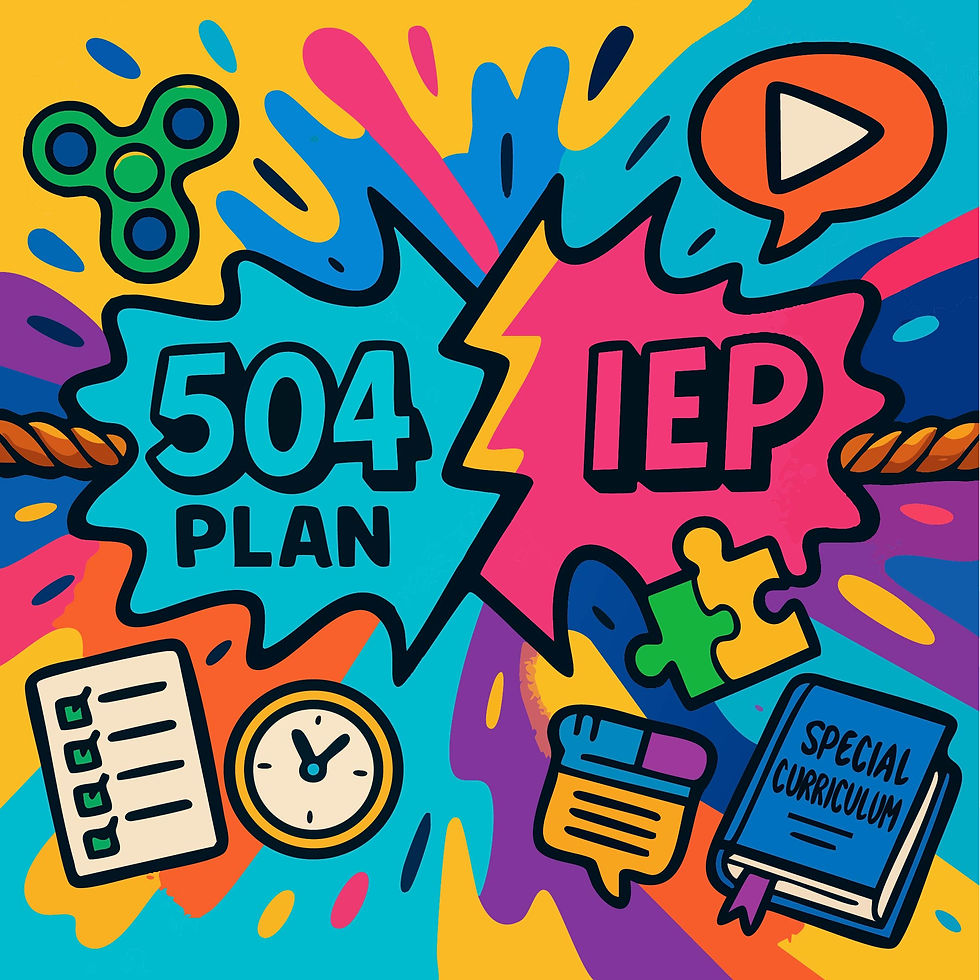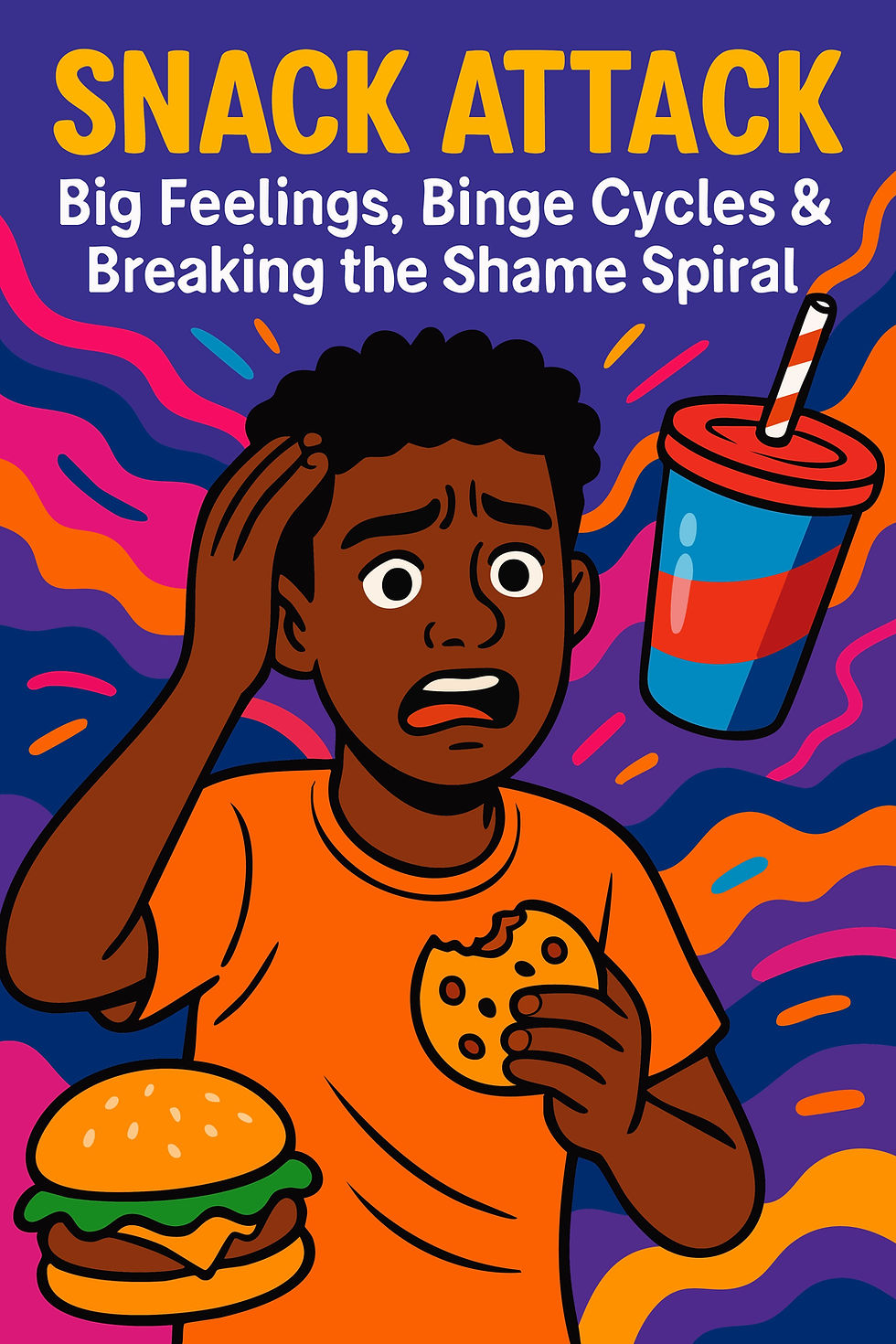504 Plan? More Like 5,000 Emails and 4 Meltdowns Later — Part 1 of 3
- Tara Gentile
- Aug 11
- 5 min read
THE FOUNDATION - The brutally honest ADHD parenting guide to what a 504 Plan actually is, why your neurodivergent kid needs one, and how to build it — with humor, grit, and real-life examples.
What Is a 504 Plan?
You’ve probably heard of an IEP (Individualized Education Program) — maybe from that one mom at the park who “just loves” laminating things and making flashcards for fun. But if you’ve never heard of a 504 Plan, you’re not alone (and honestly, congratulations on making it this far without the paperwork).
A 504 Plan comes from Section 504 of the Rehabilitation Act of 1973 — a federal civil rights law that protects people with disabilities from discrimination. Translation: if your kid goes to public school, the district must comply, no matter how much they groan about “budget constraints” or “needing to check with the principal.”
Think of it as a legally binding cheat code that helps level the playing field for students with disabilities — ADHD, autism, anxiety, sensory processing issues, learning disabilities, and more — by giving them equal access to education through accommodations.
And by “accommodations,” we mean tools that stop your kid from academically face-planting in a system designed for factory-model brains. It’s not about getting ahead — it’s about not drowning in the middle of the pool while the teacher yells, “Just swim harder!” from the deck.
Section 504 applies if your child:
• Has a physical or mental impairment that substantially limits one or more major life activities
• Has a record of such an impairment
• Is regarded as having such an impairment
This covers a lot of “invisible” disabilities — ADHD, autism, anxiety, depression, trauma-related disorders, sensory processing issues, and even the Executive Dysfunction Goblin that eats homework, hides planners, and makes them forget the thing you told them 12 seconds ago.
And if you’re wondering what counts as “major life activities,” think learning, concentrating, organizing, emotional regulation, communicating, and sitting still without vibrating like a phone on silent.
For the government-approved fine print on whether your school is covered by 504 and Title II, you can visit this U.S. Department of Education FAQ.

Is There a Difference Between a 504 Plan and an IEP?
Short answer: yes. Slightly longer answer: yes, but the differences can be about as clear as a 9th grader’s backpack on a Friday afternoon.
The Individuals with Disabilities Education Act (IDEA) is a federal law that guarantees a free appropriate public education to eligible children with disabilities. It ensures special education and related services for those children, supports early intervention for infants and toddlers (and their families), and even hands out competitive grants — because nothing says “we care about kids” like making schools fight for funding.
If you really want the government’s no-fun explanation, you can visit the U.S. Department of Education’s IDEA page.
Here’s the quick-and-dirty version:
Which One Do I Need?
✅ Go 504 Plan if…
Your kid can do the grade-level work but needs accommodations to get there without a meltdown, detention, or a permanent dent in their forehead from desk naps.
The main goal is equal access — not a completely different curriculum.
You want a legal safety net without inviting the full IEP circus into your life.
✅ Go IEP if…
Your kid needs specialized instruction or therapy to actually learn the material (think: speech therapy, occupational therapy, or “resource classes” — small-group instruction time where they can get extra help in a quieter setting without 30 other kids breathing down their neck).
Their academic goals are different from the rest of the class — not just the path they take to get there.
You’re ready for team meetings, measurable goals, and a stack of paperwork so thick it could be used as a doorstop.
Pro tip: If you’re not sure, start by asking for an evaluation. Schools love their acronyms, but they really love saying “let’s collect more data” before committing.
What’s a “Resource Class,” Really?Think of it as the school’s academic pit stop. Your kid leaves their regular classroom for a smaller group (usually 3–10 students) with a special education teacher who can actually give them more one-on-one attention. It’s quieter, less chaotic, and they can slow down or get extra help without 25 other kids sighing dramatically every time they ask a question.
Sometimes it’s just for certain subjects (like math or reading), sometimes it’s for part of the day, and sometimes it’s where they go to work on skills like organization, social thinking, or how to stop “forgetting” homework in the bottom of their backpack for a month.
Why Start with a 504 — and Why It Helps ND Kids?
Why start here:
Because it’s faster, easier, and doesn’t require surviving the full School District Bureaucracy Triathlon — a grueling event involving endless meetings, evaluation delays, and a paperwork pile that could double as a coffee table.
Thanks to the ADA Amendments Act of 2008, the definition of disability expanded to include ADHD, autism, anxiety, and other neurodivergent conditions — even when they’re “managed” by medication, therapy, or caffeine and tears.
If your child is already diagnosed outside of school, you can often get a 504 in place much faster than an IEP. Just bring that golden document to the school and say, “Hi, I’d like to schedule a 504 meeting,” and you’re in business.
If your child has not been diagnosed but you know something’s off, you’ll have to start with an IEP evaluation. You canget them tested independently — but know that if they need services, the district will still require its own evaluation before they’ll pay for anything. Translation: the school has to confirm the diagnosis themselves before opening the Special Ed wallet.
Why it helps ND kids:
Neurodivergent kids process the world differently. That means:
Transitions are harder
Instructions aren’t always clear
Tests aren’t always fair
Emotional regulation isn’t just about “trying harder”
Your kid might be brilliant — and still flailing because the environment wasn’t designed for how they operate.
A 504 Plan:
Prevents discrimination
Spells out accommodations
Holds schools accountable
Gives your kid access to education on their terms
Since most schools won’t offer this plan unless you ask, let’s talk about how to ask — and what to ask for — at every stage.
Now that you know why a 504 Plan is the starting point for most ND kids, it’s time to talk specifics. In Part 2 - The Grade-Level Playbook, we’ll get into the “what” — the copy/paste accommodation lists you’ll want for every grade, from the gold-star era of elementary school to the puberty-fueled chaos of middle school.
—Tara
504 Binder Overlord, The Giver of Valuable but Tedious Information





Comments